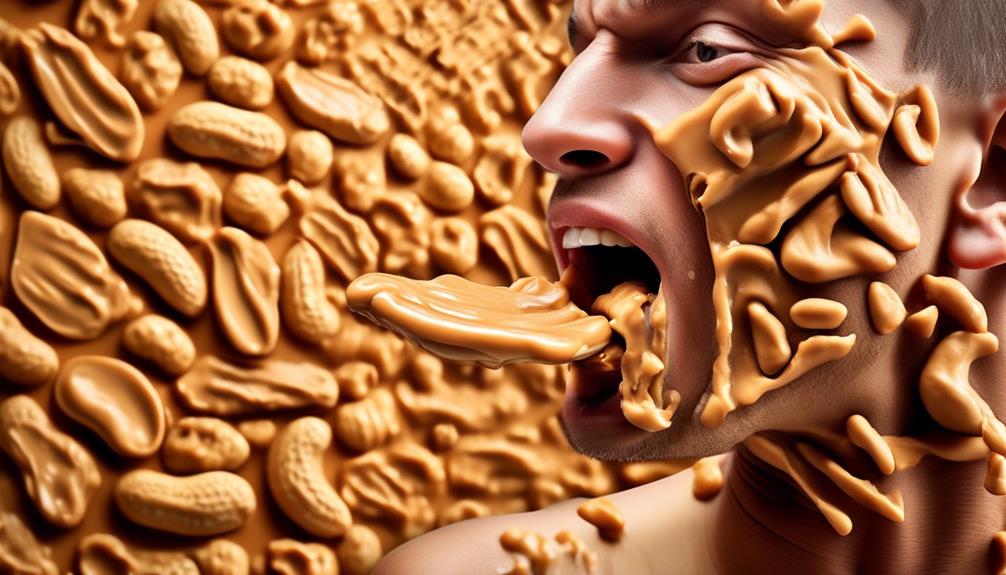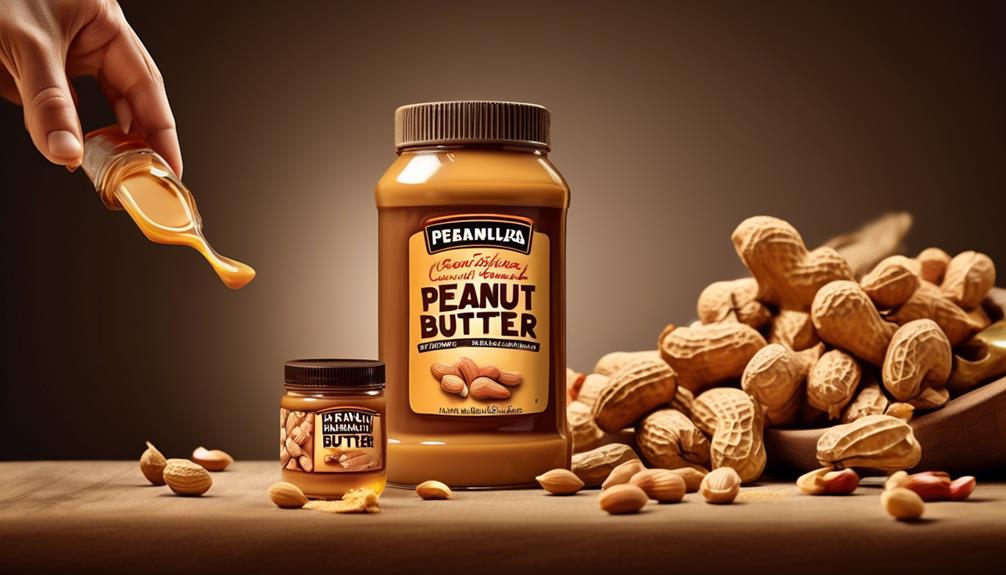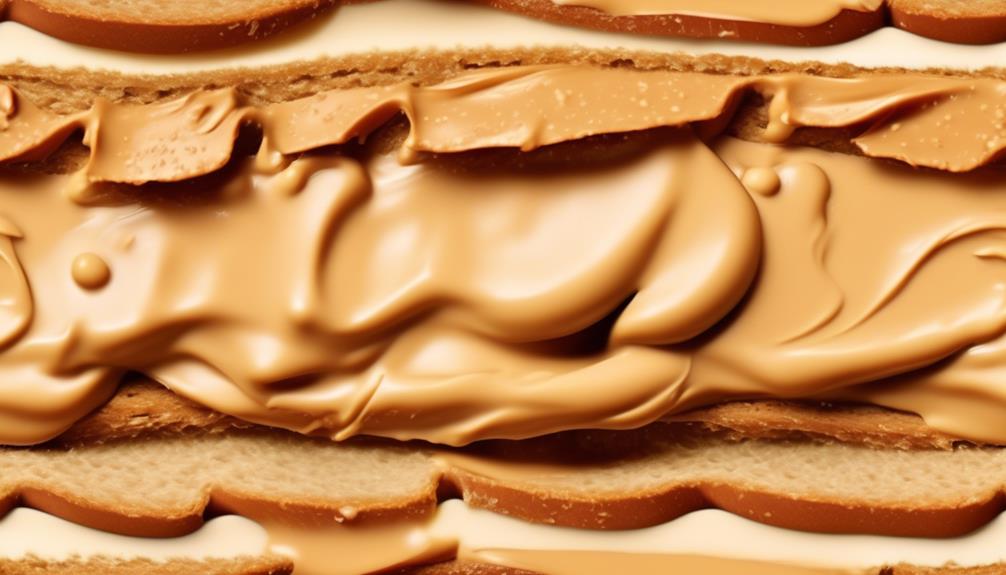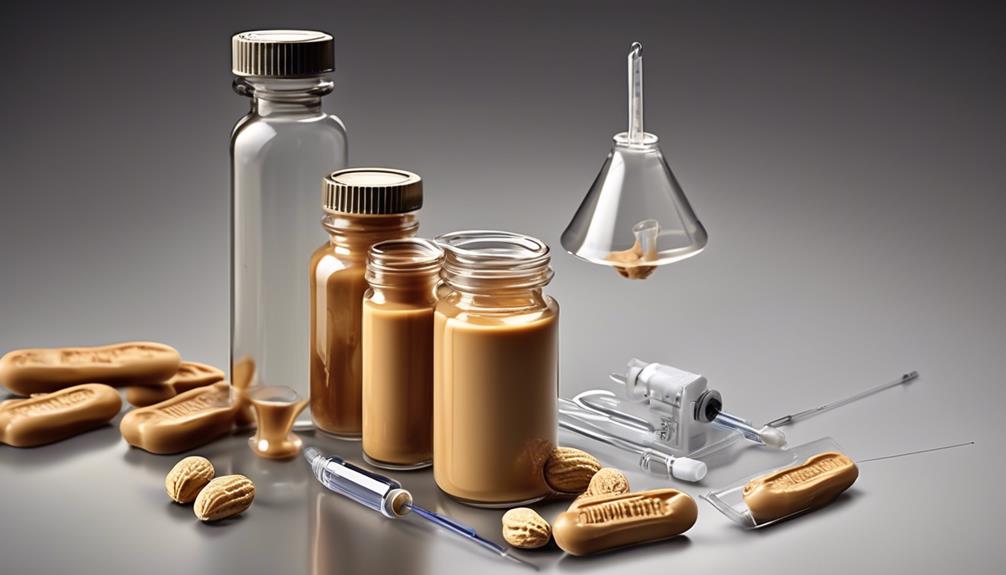After consuming peanut butter, have you ever experienced a peculiar sensation in your mouth?
It's a common experience, and the reasons behind it are quite fascinating. From the proteins in peanuts to the interaction with saliva, there are several factors at play that contribute to this peculiar sensation.
Understanding these mechanisms can shed light on why peanut butter affects our mouths in this way, and perhaps even provide insights into managing or alleviating these sensations.
Key Takeaways
- Oral allergy syndrome can cause itching, tingling, or burning in the mouth after consuming peanut butter due to the proteins in peanuts being identified as a threat by the immune system.
- Peanut oil in peanut butter can elicit allergic reactions, ranging from mouth and throat sensations to gastrointestinal symptoms, in individuals with peanut allergies.
- Cross-reactivity with other legumes can occur in individuals with peanut allergies, making strict avoidance of peanuts and peanut-containing products necessary.
- Understanding the interaction between protein agglutinins in peanut butter and saliva helps explain the various sensations and reactions experienced in the mouth after consuming peanut butter.
Understanding Oral Allergy Syndrome
We currently understand oral allergy syndrome as a specific allergic reaction in the mouth triggered by certain foods. This syndrome is particularly relevant when discussing the peculiar sensation experienced after consuming peanut butter. Individuals with oral allergy syndrome may encounter symptoms such as itching, tingling, or burning in the mouth, often leading to a feeling of discomfort.
The proteins present in peanuts can trigger this reaction in individuals with a pre-existing allergy. It's important to note that peanut butter is a common trigger for oral allergy syndrome due to its protein composition. When an individual with this syndrome consumes peanut butter, the immune system identifies the proteins in the peanut butter as a threat, leading to the release of histamine in the mouth. This histamine release is what causes the distinctive sensation experienced.
Understanding the connection between peanut butter and oral allergy syndrome can help individuals with this condition make informed dietary choices and seek appropriate medical advice. If you suspect that you may have oral allergy syndrome, consulting a healthcare professional for a proper diagnosis and management is crucial.
The Role of Protein Agglutinins

Protein agglutinins play a crucial role in the body's immune response, particularly in the context of food allergies. Understanding the effects of these proteins on the interaction with saliva and their potential to trigger allergic reactions is essential for individuals with nut and legume allergies.
Protein Agglutinins Effects
In the context of food allergies, understanding the effects of protein agglutinins is crucial for identifying and managing allergic reactions to peanuts and related legumes. When consumed, protein agglutinins can prompt the immune system to produce IgE antibodies, leading to allergic responses. These reactions can vary from mild symptoms such as itching and swelling to severe allergic reactions like anaphylaxis.
Protein agglutinins have the ability to bind to specific cells in the body, triggering an immune response and causing the characteristic mouth tingling or itching sensation experienced after consuming peanut butter. Recognizing the role of protein agglutinins is essential in managing and preventing allergic reactions to peanuts and related legumes.
Understanding these effects can aid in the development of strategies to mitigate the risks associated with peanut allergies.
Interaction With Saliva
Upon exposure to saliva, the agglutinins present in peanut butter interact with the proteins in the saliva, potentially leading to various oral sensations and reactions. This interaction can result in the formation of clumps or aggregates, causing a sticky or pasty feeling in the mouth. The agglutinins may bind to the mucosal lining, leading to a sensation of dryness or roughness. Furthermore, the interaction with saliva may trigger the release of histamine, contributing to the tingling or itching sensation experienced in the mouth. Some individuals may also experience mild inflammation or irritation in the mouth due to this interaction. To further understand the effects of this interaction, let's explore the potential reactions that can occur when peanut butter comes into contact with saliva.
| Reaction | Description |
|---|---|
| Sticky Feeling | Formation of clumps |
| Dry Sensation | Binding to mucosal lining |
| Tingling | Histamine release |
| Itching | Histamine release |
| Inflammation | Mild irritation |
Allergic Reactions Potential
Upon exposure to the mouth's mucous membranes, agglutinins present in peanut butter have the potential to elicit allergic reactions through their interaction with the body's cells, triggering inflammatory responses and histamine release.
When considering the allergic reactions potential of peanut butter, it's essential to acknowledge the following:
- Agglutinins in peanut butter can bind to cells in the body, leading to inflammatory and allergic responses.
- The interaction of agglutinins with the immune system can result in symptoms such as swelling, hives, or difficulty breathing.
- If individuals experience discomfort after consuming peanut butter, it's crucial to seek medical advice for proper evaluation of potential allergic reactions.
Understanding the role of agglutinins in triggering allergic responses emphasizes the importance of addressing any adverse reactions to peanuts and seeking professional medical advice to determine whether it's necessary to stop eating peanut butter.
Impact of Peanut Oil in Peanut Butter

Peanut butter's inclusion of peanut oil presents a potential risk for individuals with peanut allergies, as it can elicit various allergic reactions, ranging from mouth and throat sensations to gastrointestinal symptoms. The peanut oil in peanut butter has been identified as a common trigger for allergic responses in those with peanut allergies.
Upon consumption, individuals may experience itching, tingling, and swelling in the mouth and throat, which can progress to more severe symptoms. Gastrointestinal manifestations such as nausea, vomiting, and diarrhea have also been reported in some cases.
It's crucial for individuals with peanut allergies to be vigilant in examining product labels to identify the presence of peanut oil in peanut butter and to avoid its consumption. Furthermore, the potential for cross-contamination of peanut oil in other foods or through food preparation shouldn't be overlooked, as managing and preventing allergic reactions is of utmost importance.
This underscores the critical need for individuals with peanut allergies to maintain a high level of caution and awareness when it comes to the consumption of peanut oil in food products.
Enzyme Reaction in the Mouth

As we consider the enzyme reaction in the mouth, it's crucial to examine the salivary enzyme breakdown, peanut allergen sensitivity, and oral texture perception.
Amylase, a key enzyme in saliva, plays a pivotal role in breaking down starches in peanuts and other foods, potentially impacting the unique mouth sensation experienced when consuming peanut butter.
Understanding the interplay between salivary enzymes, allergen sensitivity, and oral texture perception can provide valuable insights into the complex sensory experience associated with consuming peanut butter.
Salivary Enzyme Breakdown
Immediately upon chewing, salivary enzymes in the mouth initiate the breakdown of food. Amylase begins the process of breaking down carbohydrates into simpler sugars, while lingual lipase works to break down fats into smaller molecules. Salivary enzyme breakdown is a crucial step in the digestive process, as it kickstarts the chemical breakdown of food before it even reaches the stomach. This initial breakdown by salivary enzymes not only aids in the efficient digestion of food but also facilitates the absorption of essential nutrients in the digestive system.
The intricate process of salivary enzyme breakdown sets the stage for further digestion and absorption, laying the foundation for the body to derive nourishment from the food we consume.
- Amylase in saliva targets carbohydrates, breaking them down into simpler sugars. This process aids in the initial breakdown of starchy foods like bread and potatoes.
- Lingual lipase focuses on breaking down fats into smaller molecules. This enzyme's action begins the digestion of fats even before reaching the stomach.
- Salivary enzyme breakdown plays a critical role in the efficient absorption of nutrients in the digestive system.
Peanut Allergen Sensitivity
Upon initiating the breakdown of food in the mouth, salivary enzymes play a crucial role in facilitating the initial chemical digestion of essential nutrients before reaching the stomach.
In the case of peanut allergen sensitivity, the immune system identifies specific proteins in peanuts as harmful, triggering a cascade of reactions. When these proteins come into contact with the mouth's mucous membranes, the immune system releases histamine, leading to sensations such as burning, tingling, or itching.
If individuals experience these symptoms after consuming peanuts or certain foods, consulting a physician for evaluation is essential. A diagnosis of peanut allergen sensitivity may require strict avoidance of peanuts and peanut-containing products.
Moreover, individuals diagnosed with this sensitivity should carry an epinephrine auto-injector and seek medical advice to effectively manage potential allergic reactions.
Oral Texture Perception
When consuming peanut butter, the amylase enzyme in saliva efficiently initiates the breakdown of starches into simpler sugars, thereby altering the texture and taste in the mouth.
The oral texture perception of peanut butter is influenced by various factors:
- The interaction between the proteins in peanut butter and the enzymes in saliva can create a sticky or pasty sensation in the mouth.
- The combination of fats and proteins in peanut butter can coat the oral mucosa, contributing to a sensation of thickness or dryness in the mouth.
- Some individuals may experience a slight grainy or gritty feeling in the mouth due to the presence of fine peanut particles that resist complete breakdown by saliva.
The unique texture of peanut butter, including its stickiness and thickness, can stimulate various oral receptors, contributing to a distinct mouthfeel sensation.
Interaction With Saliva Ph

The interaction between peanut butter and the pH levels in saliva can result in a peculiar mouth sensation for some individuals. When we eat peanuts or products containing peanut butter, the slightly acidic nature of our saliva can react with specific components present in the peanut butter, triggering a tingling or burning sensation in the mouth. This sensation can be attributed to the acidity of the peanut butter, which stimulates the nerve endings in the mouth, leading to an unusual feeling. Moreover, individual variations in saliva pH and sensitivity can contribute to the unique mouth feel experienced after consuming peanut butter.
| Saliva pH Interaction with Peanut Butter | ||
|---|---|---|
| Effect | Description | Prevalence |
| Tingling/Burning Sensation | Reaction between saliva pH and peanut butter components | Some Individuals |
| Nerve Stimulation | Acidity of peanut butter triggering mouth nerve endings | Common |
| Individual Variations | Unique mouth feel based on saliva pH and sensitivity differences | Varied Sensitivity |
Understanding how peanut butter interacts with saliva pH can help individuals comprehend the sensations they experience and make informed choices about their dietary preferences.
Sensory Perception and Texture

Sensory perception and texture in food play a critical role in shaping individuals' experiences with different culinary products. When it comes to the sensation of eating, the interplay between our senses and the tactile qualities of food can greatly impact our overall enjoyment and perception. In the context of peanut butter, the unique texture of this spread can elicit varying sensory responses, contributing to the mouth feeling weird for some individuals.
The tactile quality of food, often referred to as texture, encompasses aspects such as smoothness, roughness, creaminess, and crunchiness, all of which can significantly influence our sensory perception.
Factors like moisture content, fat content, temperature, and the presence of particulates or fibers in food can all contribute to the perception of texture and influence how it feels in the mouth.
The sensory experience of eating is highly individualized, influenced by factors such as taste preferences, oral sensitivity, and past experiences with certain textures, highlighting the subjective nature of sensory perception.
This variability means that what feels weird or unpleasant to one person may be enjoyable or unremarkable to another, underscoring the complexity of sensory perception in relation to food textures.
Understanding the intricate relationship between sensory perception and texture is essential in comprehending why certain foods, like peanut butter, can elicit unusual mouth sensations in some individuals.
Allergic Reactions to Peanut Proteins

Exploring the interplay between sensory perception and texture in peanut butter, it is crucial to pivot to the topic of allergic reactions to peanut proteins, a significant concern for individuals with peanut allergies. Allergic reactions to peanuts, technically legumes, can range from mild itching and tingling sensations in the mouth to severe reactions like difficulty breathing, hives, and anaphylaxis. It's important to note that these allergic reactions can also lead to allergies to other legumes due to cross-reactivity. For those diagnosed with a peanut allergy, strict avoidance of peanuts and all peanut-containing products is necessary, as even small amounts can trigger severe allergic reactions. Individuals with severe peanut allergies are advised to carry an epinephrine auto-injector at all times and seek immediate medical attention in case of a severe allergic reaction. Here is a table summarizing the key points about allergic reactions to peanut proteins:
| Allergic Reactions to Peanut Proteins |
|---|
| Symptoms range from mild to severe |
| Cross-reactivity with other legumes |
| Strict avoidance and emergency preparedness are crucial |
Cross-Reactivity With Pollen Allergens

Upon ingestion, certain pollen allergens can elicit cross-reactive responses with proteins in nuts and peanuts, leading to similar allergic reactions. This phenomenon, known as cross-reactivity, occurs when the immune system reacts to similar proteins found in pollen and certain foods.
In individuals allergic to birch pollen, consuming almonds, apples, cherries, or hazelnuts can trigger oral allergy syndrome (OAS) due to cross-reactivity with birch pollen proteins. Moreover, pollen from alder, grass, mugwort, and ragweed can also induce OAS when certain fruits, vegetables, and nuts are ingested due to cross-reactivity.
Understanding these cross-reactive patterns is crucial for individuals with pollen allergies, as it allows them to make informed dietary choices to minimize the risk of allergic reactions. Additionally, heat can alter the shape of proteins in fruits and vegetables, potentially reducing the immune response in OAS.
Keeping a food diary can aid in identifying specific food triggers related to OAS, empowering individuals to make dietary decisions that align with their needs. To explore these allergenic concerns further, individuals can make an appointment with an allergist to discuss common food triggers and potential strategies for managing cross-reactivity with pollen allergens.
Managing Peanut Butter Sensations

Consider consulting a healthcare professional if you encounter unusual mouth sensations after consuming peanut butter, as it could indicate an allergic reaction. Managing peanut butter sensations involves taking proactive steps to mitigate the risk of an allergic reaction. If diagnosed with a peanut allergy, strict avoidance of peanut butter and products containing peanuts is crucial. This can help prevent symptoms such as itching, tingling, and swelling in the mouth and throat. To ensure safety, it's important to be vigilant about cross-contamination when dining out or purchasing packaged foods. Additionally, carrying an epinephrine auto-injector may be necessary, as advised by a healthcare professional, to address severe allergic reactions. Educating those around you about your allergy is essential for creating a supportive environment, and regular follow-ups with an allergist can aid in effectively managing peanut allergies. The table below summarizes key strategies for managing peanut butter sensations.
| Management Strategies | Description | Importance |
|---|---|---|
| Strict avoidance | Avoidance of peanut butter and products with peanut ingredients to prevent allergic reactions | Crucial for safety |
| Vigilance for cross-contamination | Being cautious about potential cross-contact with peanuts when dining out or purchasing packaged foods | Minimize risk of exposure |
| Carrying epinephrine auto-injector | Consideration of carrying an epinephrine auto-injector for addressing severe allergic reactions, as per healthcare professional advice | Critical in emergency situations |
Frequently Asked Questions
Why Does My Mouth Feel Weird After Eating Peanut Butter?
When we eat peanut butter, our mouths might feel weird due to an allergic reaction called oral allergy syndrome. This can lead to sensations like burning, itching, or tingling, caused by the proteins in peanuts confusing the immune system and triggering the release of histamine.
If you experience these symptoms, it's important to stop consuming peanut butter and consult a doctor. Nut and peanut allergies can be severe, requiring strict avoidance and regular allergist follow-ups.
Why Do I Have Trouble Breathing After Eating Peanut Butter?
We experience trouble breathing after eating peanut butter due to a potential allergic reaction, causing the airways to narrow and leading to breathing difficulties. This reaction may stem from the body's immune response to peanut allergens, triggering the release of substances that constrict the air passages.
Seeking medical attention is crucial as this could indicate a severe allergic reaction. It's important to take precautions, such as avoiding peanuts and carrying an epinephrine auto-injector, to manage peanut allergies.
Why Does My Tongue Hurt After Eating Peanuts?
When we eat peanuts or peanut butter, our immune system may mistake the proteins in them as harmful, triggering an allergic reaction. This can cause discomfort like itching, tingling, and swelling in the lips, mouth, or tongue.
It's important to consult a healthcare professional for proper evaluation and management if experiencing these symptoms. Allergic reactions to peanuts can range from mild to severe, and in some cases, can be life-threatening.
Why Do I Not Feel Good After Eating Peanut Butter?
We avoid peanut butter due to potential allergic reactions. It triggers symptoms like tingling, itching, and swelling in our mouths, related to oral allergy syndrome and cross-reactivity with other allergens.
This reaction stems from the immune response, involving IgE antibodies and histamine release, causing inflammation. Managing peanut allergies requires strict avoidance, label reading, and carrying an epinephrine auto-injector for potential severe reactions. Seeking medical attention is crucial in such cases.
Conclusion
In conclusion, it's fascinating how something as simple as peanut butter can elicit such a complex and uncomfortable sensation in our mouths.
The irony lies in the fact that a food meant to be enjoyed can cause such discomfort for some individuals. Understanding the science behind these reactions is crucial for managing and preventing these sensations.
It's a reminder that even the most seemingly harmless foods can have unexpected effects on our bodies.









